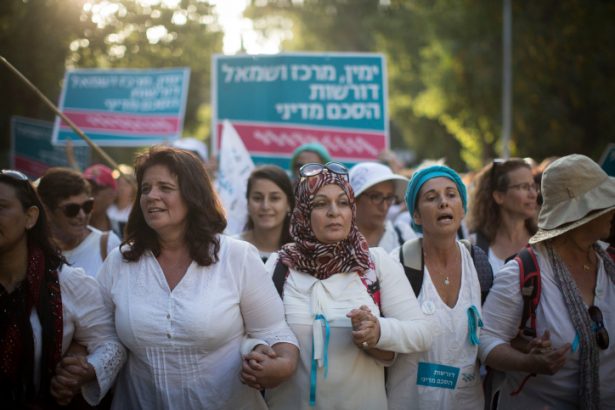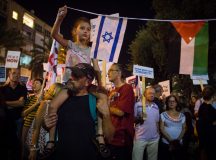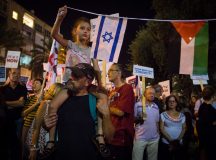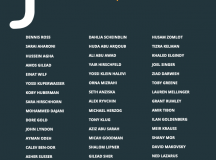With the peace process frozen, some groups – Mosaica, Shrinking the Conflict Initiative, Women Wage Peace, Shaharit, the Herbert C. Kelman Institute, Roots/Shorashim, Siach Shalom/Talking Peace and others – are working under the radar to build an alternative paradigm of peaceful relations between Israelis and Palestinians. They want peace but they define it differently to the classic Western understanding. They seek to improve Israel’s relations with the Palestinians but are disillusioned with the promise of Oslo and much of what it represents. This is their story.
Introduction: Traditional Peacemaking seems stuck
The political process between Israelis and Palestinians is on life support and has little hope of being resuscitated in the short term.
The failure of previous negotiations, the violence of the Second Intifada, Hamas’ takeover of Gaza following Israel’s 2005 disengagement, and the regional chaos following the so-called Arab Spring, have made Israelis more sceptical over territorial withdrawals. Rather than land for peace, many Israelis feel they experienced land for rockets.
Palestinians, meanwhile, continue to be plagued by geographical and political divisions between the West Bank and Gaza. They point to the consistent expansion of settlements as undermining their trust in the Oslo Process and perceive Israel’s security demands for a two-state deal to be incompatible with Palestinian sovereignty and merely an excuse to maintain the occupation.
It’s difficult to envision how significant progress can be made in the short to medium term. Israel’s new government – a strange combination between right wing Greater Land of Israel supporters, left wing opponents of the occupation, and an Islamist party – has vowed to neither annex territory nor withdraw from it. The octogenarian Palestinian Authority President Mahmoud Abbas is unpopular and short of legitimacy, especially after the cancellation of the May 2021 elections. Western policymakers had turned their attention elsewhere long before the current war in Ukraine.
With the bilateral negotiation track aiming towards an end of conflict peace agreement simply exposing the wide gaps between the sides, and Israeli unilateral options out of vogue following the aftermath of the Gaza Disengagement, the status quo continues.
Yet the Middle East – like nature – abhors a vacuum, and policy options to replace the classic Oslo paradigm are entering public discussion. Some hope to utilise the September 2020 normalisation agreements between Israel, the UAE, Bahrain, and Morocco to advance Israeli-Palestinian peace; Others such as former deputy foreign minister Yossi Beilin believe an Israeli-Palestinian confederation is the way forward. Beilin, together with Palestinian attorney and former peace negotiator Hiba Husseini, recently presented this idea to the UN. Micha Goodman’s bestselling book Catch 67 – which identified the threats for Israel of both maintaining its presence in the West Bank and withdrawing from it – as well as his subsequent articles on ‘shrinking the conflict’ are increasingly discussed in Israeli policy making circles. Rumours abound that Goodman has become an unofficial advisor to Israeli Prime Minister Naftali Bennett.
While these ideas have all made headlines, other groups are working under the radar to build an alternative paradigm to what peaceful relations between Israelis and Palestinians might look like. They want peace but define it differently to the classic Western understanding. They seek to improve Israel’s relations with the Palestinians but are disillusioned with the promise of Oslo and much of what it represents. With religious sensitivity (and violence) surrounding the Temple Mount on the rise, it is this paradigm that potentially offers the most effective chance of reducing tension. Through exclusive interviews with many of the protagonists, this essay tells their story.
Oslo and its (non-liberal) discontents
While the Oslo Accords were lauded in Western capitals, many felt uncomfortable with their overtly secular, liberal focus, which didn’t reflect the feelings of most Israelis or Palestinians. In their article ‘A Time of Peace: Divergent Temporalities in Jewish–Palestinian Peace Initiatives’ Erica Weiss and Nissim Mizrachi of Tel Aviv University explain that a majority of Israelis don’t reject peace per se but rather ‘the vision of peace offered by the mainstream peace movement.’ (When Fathom spoke to Weiss she was at pains to emphasise that non-liberal does not mean illiberal).
The rejection related both to the secular identity of the negotiators and what those negotiators represented. In other words, the perception that a peaceful resolution to the Israeli-Palestinian conflict would go hand in hand with greater secularism within both societies, something opposed by many traditionalists.
Examples can be gleaned from the two Israeli academics, Yair Hirschfeld and the late Ron Pundak, who began the Oslo process with their Palestinian counterparts. In a 2017 conversation with Fathom – after explaining that one mistake had been to exclude religious dignitaries of both sides – Hirschfeld related a story from when the delegations were invited to Spain to celebrate the 15-year anniversary of the Madrid conference. At the celebratory dinner, pork (strictly forbidden for traditional – never mind religious – Jews and Muslims) was served. Yet no one from either delegation batted an eyelid, happily finishing their portions. As Rabbi Menachem Froman of the Tekoa settlement quipped to Hamas leader Sheikh Yassin (Froman spent 25 years meeting with religious Palestinian leaders) Oslo was basically ‘our heretics and your heretics getting together and signing a peace of paper’.
For Pundak, Oslo didn’t just signify an opportunity for peace but also a process of westernisation for Israel, a means to transition the country towards ‘normalcy’, away from its Jewish-ness towards Israeli-ness. In an essay, ‘Beyond Liberal Peacemaking: Lessons from Israeli-Palestinian Diplomatic Peacemaking’, Ofer Zalzberg of the Hebert C Kelman Institute writes that ‘Bluntly put, liberal peace-making approaches share an emphasis on a correlation between the advancement of human rights, free-market, liberal democracy and international law on the one hand and on the other the promotion of global peace.’ But as Weiss and Mizrachi explain, ‘A secular language does not speak to the vast majority of Israelis, who look towards religion, tradition and the connection to the land as a major source of their identity.’ When peace is seen as the enemy of tradition, it does not gain mainstream support.
The origins of non-liberal peacemaking
The idea of garnering religious support for the peace process was perhaps pioneered by Rabbi Yehuda Amital, the head of the Har Etzion yeshiva (an Orthodox Jewish learning academy in Gush Etzion in the West Bank) and the founder of the Meimad (Religious Zionist left) party which supported the Oslo process. His legacy was continued by former Deputy Foreign Minister Rabbi Michael Melchior, who advanced specifically religious approaches to peace-making between religious leaders. However, the phenomenon that Weiss and Mizrachi point to in their article is the emergence of a new paradigm that seeks to include Oslo’s non-liberal opponents in the effort to design new inclusive approaches to peace and regional co-existence.
In 2010 Sharon Leshem Zinger, Prof. Avinoam Rosenak and Dr. Alick Isaacs founded Siach Shalom (Talking Peace). This initiative began by convening groups of senior leaders in Israel to come together for group dynamic workshops in which the participants explored the conflicting visions about what peace means to them. Siach Shalom was successful in facilitating meaningful conversations between leaders who were either involved in or supporters of the Oslo process and senior Rabbis from the ideological settlements who were their most vehement opponents. These workshops, which ran for over decade, influenced many of the people on both sides of the political spectrum, who have since moved into the field of post-liberal peace-making.
Sharing the land may be necessary, but connection to all of it remains
Another issue non-liberal communities had with the peacemaking paradigm as represented by Oslo related to the concept of partition.
For Zalzberg ‘the liberal utopia of a conflict-ending distributive compromise clashes with religious visions and eschatologies which maintain that the land is sacred and therefore indivisible.’ Accordingly, he argues, ‘among the major reasons for the failure of these agreements to win broad, lasting support in both Israeli and Palestinian societies was the omission of consideration of beliefs about the land’s sanctity held by large and powerful constituencies in both societies.’
In their sociological fieldwork, Weiss and Mizrachi relate how religious Jews and Muslims rejected the idea that the Holy Land was in any way divisible. Several groups pointed out the artificial (and in their eyes illegitimate) nature of the 1949 Armistice / Green Line. ‘Both Islamists and religious Jews that we worked with’ they write ‘saw the entire area of the historical holy land and historical Palestine as indivisible.’ For them, the ‘occupied territories’ are not more or less occupied than Tel Aviv or anywhere else on the Israeli side of the Green Line.’
It’s not a real estate problem
Perhaps the Oslo paradigm didn’t fully grasp the core of the conflict. ‘The problem wasn’t only partition of sacred land, but also not seeing it as sacred land’ Daniel Roth of Mosaica told Fathom. Instead, it was considered ‘as a scarcity of resource conflict, or just an issue of real estate conflict’. Barak Loozon, a social activist agrees. In a conversation with Fathom, he explained that ‘Many in the West don’t get that it’s not a real estate problem but about connection to the land.’ The American perspective, according to Loozon, ‘is often influenced by the separation of church and state and feels that separation is always an asset.’
Listening to Loozon, I was reminded of something written by Middle East historian Bernard Lewis in his 1998 book ‘The Multiple Identities of the Middle East’. There, Lewis argues that ‘the modern, secularized Westerner has great difficulty in understanding a culture in which not nationality, not citizenship, not descent, but religion, or more precisely membership of a religious community, is the ultimate determinant of identity.’ For Lewis, even in countries where there is no formal separation of Church and State, ‘the modern Western observer no longer attaches primary importance to religious identity; he therefore has difficulty in grasping that others may still do so, and will tend to see-or seek-a nonreligious explanation for ostensibly religious conflicts.’
When we say ‘peace’ what do we imagine?
Liberal and non-liberal communities also differ in their perceptions of the nature of peace as well as the significance of a peace agreement itself. Weiss and Mizrachi believe this is based on different understandings of the concept of time. ‘The liberal notion of time assumes a linear temporal progression towards a peace agreement that will usher in a permanent peace in accordance with democratic peace theory’ they write. ‘By contrast, the temporal ideal of peace envisioned by many non-liberal Jews and Palestinians involved in the conflict is more prosaic and inherently impermanent.’
‘The liberal Zionist peace process envisions peace arriving with a peace agreement, marked by a handshake reminiscent of the one between Yitzhak Rabin and Yasser Arafat’ Weiss and Mizrachi argue. ‘In this vision, there is a “solution” to the conflict. There is forward and backward, progressive and regressive; forward is a movement towards a permanent solution to the conflict, backward is anything perceived as an obstacle.’ Not so for others. They explain:
Peace in the non-liberal worldview is not an event, but a quantitative modulation of relations: less violence between Jews and Palestinians; more fair and just interactions as the groups meet in the public sphere; more respect for integrity and autonomy of the communities. They see this peace as something that is never finally achieved, but as an ongoing struggle, a relationship that requires constant maintenance. Like any other relationship, the relationship between the communities can be strong or weak, but it is inherently dynamic and vulnerable to deterioration’.
In a phone conversation with Fathom, Weiss adds that ‘the way in which the secular or liberal understand peace is as an end point. And once that point is reached it will be fantastic. We will “achieve” peace. Yet amongst religious people I know this concept is insane – there will always be two peoples, there will always be issues, regardless of whether there is a [peace] contract.’ Zalzberg concurs. Speaking over lunch in Jerusalem, he explains that ‘In the liberal notion, conflict resolution delivers a harmonious solution. There is a sense that contradictions and mutually exclusive claims need to be resolved rather than acknowledged.’
Enter the religious
For Rabbi Melchior, religious leaders have to be part of any negotiation process, as does recognising the reality that another people live in the land, (which Melchior believes must be part of a divine plan). ‘When the religious sit together’ he told Fathom in a 2016 interview, when ‘you see the radical rabbis sitting, learning together with Islamists, they realise that these are serious people who aren’t going anywhere. Nobody is betraying their religion, their tradition, their dreams; they remain fully loyal to those things. But they are willing to face reality and to find a political compromise.’
Roth provides an additional angle of the importance of incorporating religious leaders. ‘International liberal diplomatic mediation is very important but not sufficient’ he tells Fathom. ‘When you have Islamist Sheikhs who can speak to the top Islamic leaders in Qatar, Saudi Arabia and Egypt…religious leaders who are codifying the fatwas – regarding the status of the State of Israel, the nature of peace and war, of violence and non-violence etc, no US diplomat or western mediator has any ability to engage in that conversation.’
In this context, one shouldn’t necessarily be put off by rhetoric of territorial maximalism. ‘We have to say this land belongs to us’ Melchior says. ‘It’s not maximalist. It belongs to us. We believe in it and have the connection to it. To divide the land is a tremendous sacrifice. It is like cutting off a part of our body. But sometimes one has to do just that to survive.’ While belief in territorial maximalism on the one hand and willingness for territorial compromises on the other may seem counterintuitive to some Melchior sees it as the way forward. ‘Saying we should have nothing to do with Hebron, Otniel and Shiloh is cosmopolitan political talk which ignores the issue of identity’ he states. Melchior should know. In his role as President of Mosaica (and even before then), he has held dozens of meetings with senior Islamic clerics to help advance support for religious peace, issue rulings against suicide attacks, reduce tension on the Temple Mount, and more.
Where should we go from here?
Weiss convenes a forum of the Van Leer Centre and the Shaharit institute that brings together a number of groups: Mosaica, Women Wage Peace, the Herbert C. Kelman Institute, Shorashim/Roots, Siach Shalom/Talking Peace and others.
Weiss tells Fathom that the forum explores ‘whether there is some other kind of grammar or approach to the question of peace from a different post-liberal, or non-liberal or religious perspective’.
‘On the one hand these groups have a lot in common’ Weiss says. ‘On the other, there is a lot of diversity in approach, methodology, philosophy. They are trying to offer another way, an understanding that the mainstream peace camp is not going to be able to offer most Israelis and Palestinians what they need to move forward.’ At its core, it’s an attempt to approach peacemaking from a non-liberal perspective ‘What might peace that isn’t part of a western liberal grammar or paradigm look like?’ Weiss wonders.
There is also a strategic component to including non-liberal voices. ‘If you think about peace-making outside of an exclusively liberal frame’ says Zalzberg, ‘you can gain support from unexpected places, including known spoilers or extremists, thereby potentially creating new pro-agreement constituencies coalitions in both societies.’
But what’s the solution?
All of this may sound nice, but readers might wonder how these groups envision a solution. Are they one-staters or two? Supporters of confederation or annexation?
A political common denominator doesn’t necessarily exist between Israelis and Palestinians, nor even amongst Israelis themselves. Rabbi Avi Gisser of the ideological settlement of Ofra and member of Mosaica’s Religious Peace Initiative steering committee has vastly different views to Melchior of how the conflict should be resolved.
But for these groups, trying to pinpoint a solution is asking the wrong question. ‘It’s not only about the nature of solution but about who the messenger or the mediator is’ counsels Roth. ‘Without insider mediators you can’t transform intractable identity conflicts, such as this one.’
Alick Isaacs of Siach Shalom sees the presence of these ‘non-liberal’ groups as reflecting the need for the Western world to think outside that box if they want progress. Such thinking would not necessarily mean giving up on a two-state solution. But it would require the willingness to hear what opponents of classical liberal peace-making have to say about it and understand that they have other aspirations and paradigms.
In a conversation with Fathom Isaacs expresses his conviction that ‘the way to get there is not to decide what the solution is and then to provide political pressure so everyone fits in with that box’. ‘You have to listen to the Israeli electorate’ he urges. ‘They’re not stupid. Neither is the Palestinian public.’
‘If you want a peaceful outcome’ Isaacs says, ‘you need to define peace in ways that make more sense to the people who are living in this region. You have to listen to their concerns and to imagine that they are speaking about their concerns in the context of a different cultural paradigm from yours.’





































